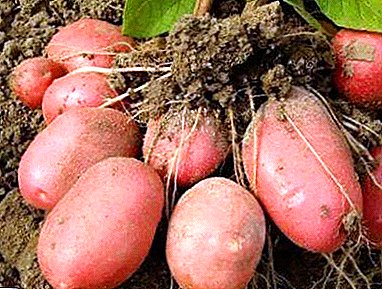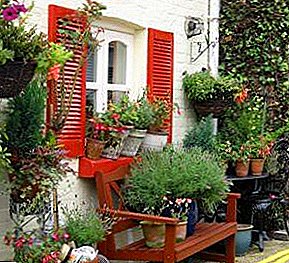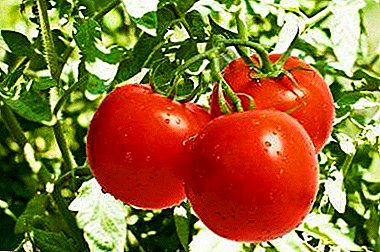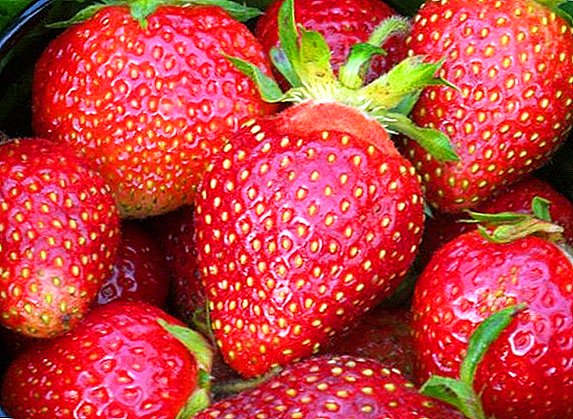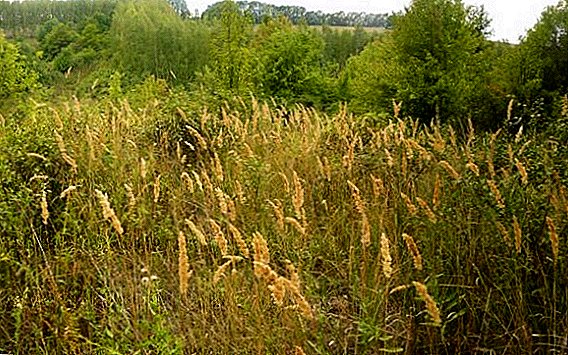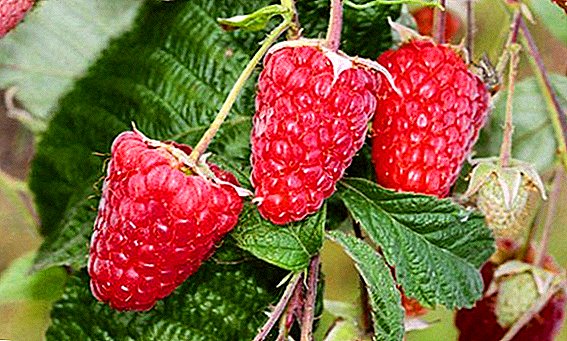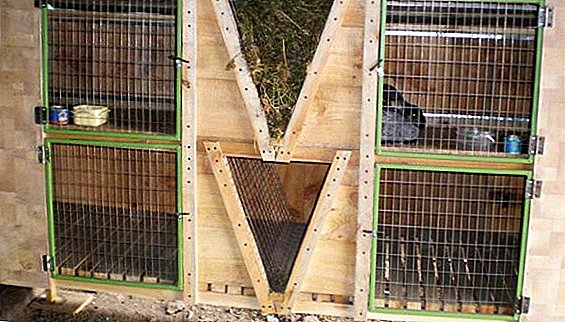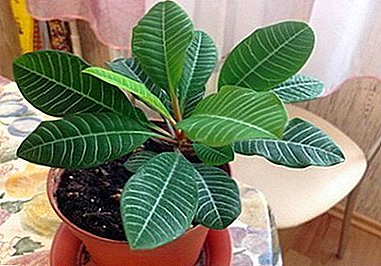
Indeed, a long “trunk” with a tuft of widely spread pedunculate leaves on top looks like a palm tree silhouette, but the similarity is purely external.
Euphorbia ribbed, also called comb or comb, belongs to the vast family of plants with poisonous milky sap - Euphórbia, Euphorbia.
The homeland of ribbed euphorbia is subtropical and tropical coastal forests of the island of Madagascar, where it grows on sandy soils.
Description
The pentahedral dark green stem with gray scars, usually without branches, is topped with a bunch of large, elongated-oval, bright green, glossy leaves with reddish petioles.
The underside of the leaves is very light; it serves as a reflector and additionally illuminates the foliage with sunlight.
On the lower, browning parts of the stem, the faces smooth out and disappear.
In the summer, starting from the first year of life, the plant blooms, forming apical inflorescences of several flowers - each with two white or pink "petals" -practices.
Euphorbia comb refers to unpretentious species, simple at home content. Such varieties are also very popular in cultivation: Multifloric, Edged, Cypress, Tirukalli, Pallas, Mil, Belozhilkovy, Trihedral.
A photo
Next, you can see the spurge (ridge):
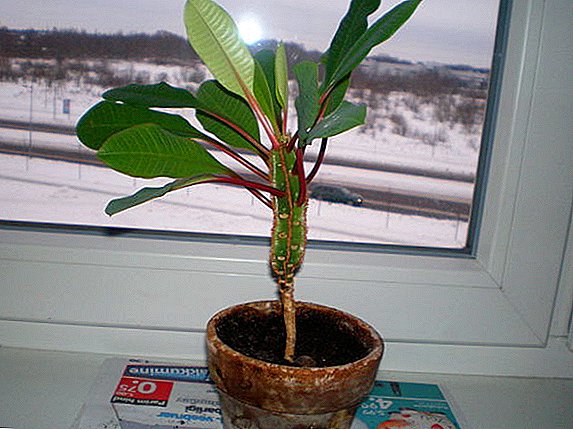
Care
For successful care at home for euphorbia ridge (comb) you must comply with the following conditions:
Lighting
Comb spurge photophilous, but intense and prolonged sun exposure does not benefit him: the plant burns leaves and grows on the stem-stem protective cover from rough brown fabric.
To preserve the attractive exotic look of this euphorbia, you should place it on east or west window.
On the south side you will need a mandatory shading, and on the windows of northern directions light illumination.
Temperature
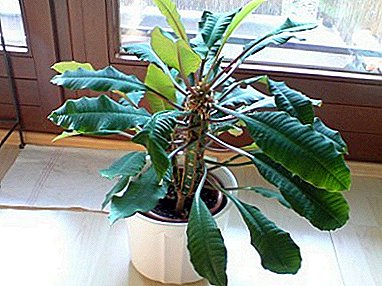 For a native of the tropics and subtropics the optimum temperature range of the summer period 20-25 degrees, winter - about 16 degrees.
For a native of the tropics and subtropics the optimum temperature range of the summer period 20-25 degrees, winter - about 16 degrees.
Such a decrease in temperature will ensure a slower growth and spurge will not be pulled out in conditions of low winter illumination.
Summer is very useful to put the plant to the balcony, providing protection from excessively long sunbaths and strong wind ...
The soil
In the habitats of combed erythmya common sandy soil, not too saturated with nutrients, - and in room culture for him suitable soil for cacti and succulents: loose, slightly acidic, moderately nutritious.
You can also mix equal quantities of leafy soil, peat and sand, or prepare a substrate containing two parts of humus, one part of leafy land, two parts of sand, and one part of peat.
Planting, transplanting
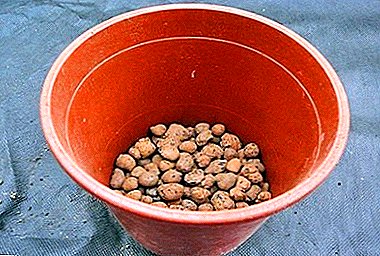 When planting ribbed milkweed, care should be taken to ensure good outflow of water, since the main danger for this undemanding Madagascar is soil moisture stagnationleading to rotting of the stem and root system.
When planting ribbed milkweed, care should be taken to ensure good outflow of water, since the main danger for this undemanding Madagascar is soil moisture stagnationleading to rotting of the stem and root system.
At the bottom of the planting container must be placed drainage layer - expanded clay or small pebbles.
You can also add pieces of charcoal.
When planting euphorbia, special attention is paid to the root system: it should not be damaged and overmoistened.
Therefore, the old soil on the roots as possible preserve and the first days after planting the plant water moderatelyaccording to the season.
The best time for a transplant is Spring; frequency of transfers - once in 2-3 years.
If you purchased euphorbia and it is in a shipping container, it should be, without delay, transplant in a suitable-sized container, ensuring good drainage and contain in accordance with the time of year at which the transplant occurred.
Watering
 In spring and summer water the plant relatively abundantlyone to two times a week, soft, good settled water at room temperature.
In spring and summer water the plant relatively abundantlyone to two times a week, soft, good settled water at room temperature.
In the fall, watering is reduced, and in winter, at a slightly reduced temperature, watering comb spurge is used to prevent the soil from drying: once or twice a month.
If wintering is warm, water will be needed more often.
Air humidity
Spurge ribbed, as a typical representative of its kind, well carries dry airbut to him useful water treatments - infrequent spraying, which washes away the dust from the leaves and the stem, and also creates an obstacle for the attacks of insect pests: many of them settle more readily on the dry surface of the plants.
Top dressing
In the spring-summer period of active growth, the ridge-dresser is needed weekly feeding.
It is best to use special formulations for cacti and succulents.
Ready-mix for indoor plants can also be used, but, before feeding the plant, they need to be strongly to breed.
This spurge responds well to increased potassium content in top dressing.
In the autumn, and especially in the winter feeding need not.
Bloom
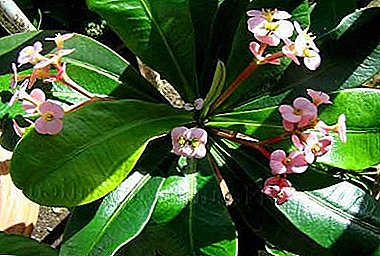 Special conditions in order to bloom, spurge does not require and if it is light, warm and not too wet, it readily, starting from the first year of its life, forms pretty pink or white inflorescences on reddish or yellowish-green peduncles in the upper part of the stem.
Special conditions in order to bloom, spurge does not require and if it is light, warm and not too wet, it readily, starting from the first year of its life, forms pretty pink or white inflorescences on reddish or yellowish-green peduncles in the upper part of the stem.
Seeds are easy to set; after ripening the plant scatters them from ripe boxes in all directions a meter away.
Seed germination also the good.
Breeding
Ribbed Euphorbia can breed cuttings and seeds.
Cuttings
With this method of reproduction, you need to consider that this type of milkweed branches reluctantly, and therefore, if you cut the top of the parent plant on the cutting, it lose decorativeness.
For this reason, propagation by cuttings rarely used, in special cases - for example, if the plant is affected by root rot and you need to save its healthy top.
The cutting is best done in the middle of summer, in July.
The top is cut off, allowed to drain the milky juice, powdered slice charcoal powder.
The resulting stalk is dried 2-3 days in the shade and planted for rooting in a moist soil mixture of lightweight composition: sand and peat in equal proportions.
Seeds
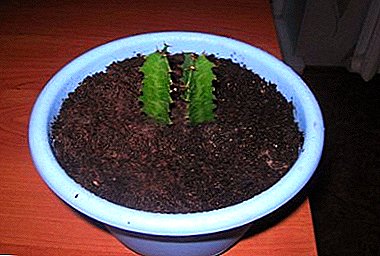 Ribbed milkweed seeds have excellent germination and abundantly germinate in all the pots next to the plant.
Ribbed milkweed seeds have excellent germination and abundantly germinate in all the pots next to the plant.
Such self-seeding has even to limit.
For the target, controlled, sowing, the harvested, ripened seeds are placed on the soil surface and covered with glass.
Shoots appear quickly. Soon the young plants can be planted and looked after them, as if they were completely grown up: water, feed, load into more spacious pots.
By next summer they will reach a height of 15 cm and for the first time in their life they will bloom.
Diseases and pests
Signals of trouble:
- The stems are pulled out, the leaves shrink - insufficient lighting.
- Leaves fall and fall - drying of the soil.
- The leaves turn yellow and fall off - waterlogging or sudden changes in temperature drafts.
Under normal conditions for euphorbia, the content of these plants hardly ill.
Excessive moisture becomes the cause of rot. Especially dangerous root rot.
With a strong lesion should cut off the healthy apical part, root it and keep it in the right conditions, and Eliminate the rest of the plant.

If there is a shortage of nutrients, space and light, and the moisture stagnates, spurgeon ridge strikes powdery mildew.
Such a plant is isolated and treated with fungicidal drugs, a solution of copper sulphate.
Further optimize conditions of detention.
On the leaves of a weakened plant can live aphid or red spider mite. Affected areas should be treated immediately.
Can apply soap solutionbut the most effective remedy against such pests is insecticides of systemic action.
Underground part of milkweed can attack root mealybug. If this happened, the roots are washedand earth treated with insecticide for the soil.
Medicinal properties and contraindications
The genus of milkweed is named Euphorbia by the name of the ancient physician Evforba, who, according to legend, was the first to use their poisonous milky juice as a medicine: it’s known since the days of Hippocrates: only the dose determines whether it is poison or medicine.
Milkweed juice ribbed is poisonous, as with all milkweed.
On the skin it causes allergic reactions and burns; getting into the body leads to burns of mucous membranes and poisoning, causes burning in the mouth, nausea and vomiting.
 Therefore the plant not recommended to grow where there are small children and pets.
Therefore the plant not recommended to grow where there are small children and pets.
However, the same juice, or rather, an infusion of sliced leaves in boiling water, helps get rid of age spots, remove dry calluses and warts, cope with fungal skin lesions.
In this case, the dose and time of exposure should be strictly limited. Milkweed decoction used in diseases of the stomach and liver. Alcohol preparations of milkweed comb used in homeopathy.
Spurge ridge (comb, ridge-ribbed) - flowering succulent with an exotic "appearance", care at home is not particularly difficult, so the plant will decorate your home for many years, and with proper use and due care can also be effective drug.


